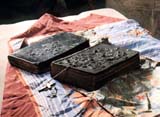|
I am going; you will stay with the living; From time immemorial, pictures and the written word had something magical about them. The messages written or drawn by mysterious markings carried their meanings through the space and time, having the same quality of immortality like gods. Many cultures associate the invention of their writing with some magical or mysterious event reinforcing the concept that there is something divine in writing. Thus written words become divine messengers, a way of communications between humans and divine. In the mountains of Himalayas prayer flags, inscribed with prayers, send their message with the winds that wave them. In Shintoism, prayers are written on the paper and tied to a tree for wishes to be heard. For religions of the Middle East at the beginning, it was the Word that was written down in the Book. The divine powers associated with the word and picture could be clearly seen in the Armenian treatment of books, especially the books of the Bible. In medieval Armenia copying the manuscript was not only a monk's chore, it was a devotional act par excellence. In colophons of the manuscripts, scribes often describe themselves as lowly and unworthy of the task of the reproducing the Divine word and joining their name in to the "Book of Life." The medieval Armenia names inscribed on a sacred object - wall of the church, a memorial cross stone (khachkar), or ecclesiastical paraphernalia - are written there for God to read and remember them. Following those beliefs, the object with inscribed names, handed down through the generations, especially of religious character like manuscripts, handwritten charms, crosses or parts of khachkar would be carefully wrapped up in the embroided cloth and placed on the family shrine and function as "saint of the home" (tan surb), protecting their owners from evil and misfortune. Books in particular had a power to protect from disasters, help curing disease, and ensure prosperity of the whole community in which they reside. The tan surb books would be worshiped with offerings of a sacrifice and the burning of candles. They would be taken out and opened only if some extraordinary need occurs, particularly associated with physical illness. In 19 thcentury even priests of Armenian church would perform healing services involving tan surb. More than once official, the Armenian church tried to quash these practices, in particular the worshiping of the books, but had little success. As late as in 1960s (soviet) Armenian government tried to collect manuscripts and old books held in private possessions, for preservation in state run manuscript depository (matenadaran), but the people refused to hand them over. Even books deposited in the Matenadaran Library today, retain their saintly status and people bring flowers and offerings to the books, to the chagrin of the staff. Throughout history, this extraordinary reverence for the book also created a peculiar tradition of rescuing and redeeming manuscripts when they were seized by an enemy or under threat to perish in one of the many pogroms Armenians endured. The colophon of Baron Martiros in the Gladzor Gospels is the testimony to that tradition. However, the legends about the books and sacrifice Armenians are prepared to endure for their books did not end with the Middle Ages. The one, often mentioned, story is of rescue of the Mush Menologium (Homilies of Mush), an enormous 13th century manuscript measuring 55.3×70.5 cm, and weighting 28 kg. In the year 1202, the manuscript was captured, but it was bought back for 4.000 silver coins and held, until the WWI, in the Holy Apostles Monastery in Mush, Turkey. In the year 1915, two sisters fleeing the pogrom brought it out of Turkey. But the codex was so big that they needed to cut it in half in order to carry it. As the story goes, even halves were so heavy that they buried one part in the courtyard of the Erzrum church, split the other part again, and brought the remains to the Echimadzin, Holy see of the Armenian Church. The buried part was later find and the manuscript was rebind and now it is deposited in the Matenadaran in Yerevan. Although it frowns on book worshipping, the church well understood the value of books for the survival of the independent Armenian church and Armenians themselves. It organized the first book depository (matenadaran) in the 5th century in the town of Vagharshapat, not long after the invention of the Armenian script (401 AD). Later, the depository was moved to the Holy Etchmiadzin, the seat of the Armenian church. The current building, on the slopes above the Yerevan, was completed in 1957. Armenian illuminated manuscripts Bibliography Abrahamian, L. and Sweezy, N. (Ed.), Armenian folk arts, culture, and identity. Indianapolis: Indiana University Press. Marsden, P. (1995). The crossing place: A journey among the Armenians. New York, Tokyo, London: Kodansha International. Taylor, A. (1995). Book arts of Isfahan: diversity and identity in seventeenth-century Persia. Malibu: J. Paul Getty Museum Zenian, D. (1996). The Matenadaran: The other "central bank" of Armenia. AGBU, 6(2), p. 11. Copyright 2006, Vlasta Radan, all rights reserved. |


